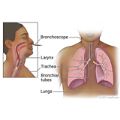How It Is Done
You may be asked to remove dentures, eyeglasses or contact lenses, hearing aids, wigs, makeup, and jewelry before the bronchoscopy procedure. You will empty your bladder before the procedure. You will need to take off all or most of your clothes (you may be allowed to keep on your underwear if it does not interfere with the procedure). You will be given a cloth or paper covering to use during the procedure.
The procedure is done by a thoracic surgeon or a pulmonologist and an assistant. Your heart rate, blood pressure, and oxygen level will be checked during the procedure.
A chest X-ray may be done before and after the bronchoscopy.
Flexible bronchoscopy
During this procedure, you will lie on your back on a table with your shoulders and neck supported by a pillow, or you will recline in a chair that resembles a dentist's chair. Sometimes the procedure is done while you are sitting upright.
You will be given a sedative to help you relax. You may have an intravenous line (I.V.) placed in a vein. You will remain awake but sleepy during the procedure. In some situations, you may have general anesthesia to make you sleep.
Before the procedure, your doctor usually sprays a local anesthetic into your nose and mouth. This numbs your throat and reduces your gag reflex during the procedure. If the bronchoscope is to be inserted through your nose, your doctor may also place an anesthetic ointment in your nose to numb your nasal passages.
Your doctor gently and slowly inserts the thin bronchoscope through your mouth (or nose) and advances it to the vocal cords. Then more anesthetic is sprayed through the bronchoscope to numb the vocal cords. You may be asked to take a deep breath so the scope can pass your vocal cords. It is important to avoid trying to talk while the bronchoscope is in your airway.
An X-ray machine (fluoroscope) may be placed above you to provide a picture that helps your doctor see any devices, such as forceps to collect a biopsy sample, that are being moved into your lung. The bronchoscope is then moved down your larger breathing tubes (bronchi) to examine the lower airways.
If your doctor collects sputum or tissue samples for biopsy, a tiny biopsy tool or brush will be used through the scope. A salt (saline) fluid may be used to wash your airway, then the samples are collected and sent to the lab to be studied.
Finally, small biopsy forceps may be used to remove a sample of lung tissue. This is called a transbronchial biopsy.
Rigid bronchoscopy
This procedure is usually performed under general anesthesia. You will lie on your back on a table with your shoulders and neck supported by a pillow.
You will be given a sedative to help you relax. You will have an I.V. placed in a vein. Once you are asleep, your head will be carefully positioned with your neck extended. A tube (endotracheal) will be placed in your windpipe (trachea) and a machine will help you breathe. Your doctor then slowly and gently inserts the bronchoscope through your mouth and into your windpipe.
If your doctor collects sputum or tissue samples for biopsy, a tiny biopsy tool or a brush will be inserted through the scope. A salt (saline) fluid may be used to wash your airway, then the samples are collected and sent to the lab for biopsy.
Recovery after bronchoscopy
Bronchoscopy by either procedure usually takes about 30 to 60 minutes. You will be in recovery for 1 to 3 hours after the procedure. Following the procedure:
- Do not eat or drink anything for 1 to 2 hours, until you are able to swallow without choking. After that, you may resume your normal diet when your doctor says it's okay, starting with sips of water.
- Ask your doctor when you can drive and use heavy machinery again. If you go home on the day of your procedure, someone will need to drive you home.
How long the test takes
A bronchoscopy (either flexible or rigid) usually takes about 30 to 60 minutes. You will be in recovery for 1 to 3 hours after the procedure.


